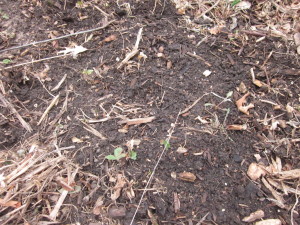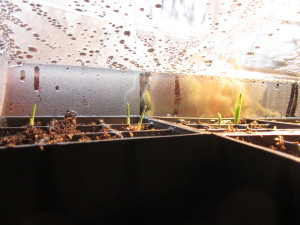It's spring in Minnesota, which found me flinging hairy vetch seeds from a flowerpot into the back yard.
Let's back up a moment. My garden fever has been ramping up; those of you who live in the great frozen north might understand the hunger to see green things. It's why all the undergrads were in shorts last week (that and we set a record of 84 degrees!). For the past few years my husband & I have tried to start seeds in egg containers, and every year something terrible happens: they blow off the porch, or they all drown in a big rainstorm, or squirrels eat them. No more. This year I marched into Eggplant Urban Farm Supply a few blocks away and made a stand. I spent what felt like an exorbitant amount of money, but it'll be less than a dollar a plant even if we have a few failures. I got a seed-starting tray and a seed heater for our cold house and some hairy vetch and inoculant for nitrogen fixation!
Nitrogen what?
Nitrogen is one of the most important nutrients for plant growth, especially for corn. That's why farmers apply nitrogen-based fertilizers. Last spring I published some worksheets about nitrogen runoff in the Raccoon River: spring melt washes away nitrogen that wasn't absorbed by the soil or plants. Last month I updated that story with some info about Des Moines Waterworks suing local counties for letting too much nitrate wash away: it's really expensive to remove, but you have to, or babies turn blue and die! (Nitrates in our water blocks oxygen transport in our blood.) So, from this blog, I've learned something about nitrogen. And we did a soil test in our back yard and learned our nitrate/nitrite/nitrogen of any kind levels are very low. And this year...
This year we're going to try a Three Sisters garden. Why? I went to North Coast Nosh curated by Sioux chef Sean Sherman and the food was amazing. And I loved the little garden Fort Snelling used to have. And I bought Buffalo Bird Woman's Garden: Agriculture of the Hidatsa Indians , a book of garden wisdom from one woman's memory of her life, first published in 1917, and Original Local: Indigenous Foods, Stories, and Recipes from the Upper Midwest
by Heid Erdrich, full of more modern stories, and I was reading the chapter on the three sisters in Braiding Sweetgrass: Indigenous Wisdom, Scientific Knowledge and the Teachings of Plants
. So. Three sisters. We'll give it a try.
But for this corn, I need more nitrogen in the soil and I'm afraid compost won't be enough. Remember how in the recent nitrates post I mentioned no-till agriculture? I'm not a farmer, but I started to read about cover crops. I'd planned to try them in the fall, but Eggplant had that hairy vetch, sitting next to the seed-starting supplies, for only $6.25... And that's how I got to be spring flinging hairy vetch covered in inoculant slurry into the garden last weekend. And reading a lot of pdfs on the math of cover crops!
Turns out there is a fair bit of research on nitrogen fixation of cover crops. I've been looking at the CENTURY model of soil organic matter but there are also papers on simpler studies of nitrogen fixation by different plants (clover, vetch, rye, oats). To break up the butterfly madness, I'm prepping an activity on nitrogen fixation by cover crops. It seems like a theme this spring is transitions: transitions between butterfly habitats, between bee life-stages, between garden clippings and fully composted soil. More differential and difference equations to come!
Next week, nitrogen fixation and cover crops. Will this change your fall garden?
Disclosure: This website may receive a commission for sales of the books we link to. I do actually own all these books and recommend them!


